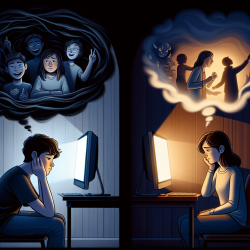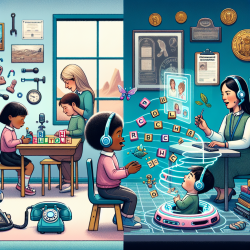Introduction
Adolescence is a critical developmental period characterized by numerous challenges, including social anxieties and sleep difficulties. Recent research, such as the study titled "Anxious-Withdrawal and Sleep Problems during Adolescence: The Moderating Role of Peer Difficulties," highlights the complex interplay between anxious-withdrawal, peer difficulties, and sleep problems in adolescents. This blog explores how practitioners can leverage these findings to improve outcomes for adolescents struggling with these issues.
Understanding Anxious-Withdrawal and Sleep Difficulties
Anxious-withdrawal is a behavioral tendency where adolescents withdraw from social interactions due to anxiety and fear. This behavior is linked to various psychological difficulties, including anxiety, depression, and loneliness. The study in question provides new insights by examining the relationship between anxious-withdrawal and physical health outcomes, particularly sleep difficulties.
The study identifies six types of sleep difficulties associated with anxious-withdrawal: sleeping too much, sleeping too little, talking/walking in sleep, being overtired, nightmares, and general trouble sleeping. Importantly, it reveals that anxious-withdrawal is prospectively associated with sleep problems, especially in adolescents who experience peer exclusion and victimization.
Implications for Practitioners
Practitioners working with adolescents can use these findings to enhance their interventions. Here are some strategies to consider:
- Comprehensive Assessment: Conduct thorough assessments that include evaluations of anxious-withdrawal behaviors, peer interactions, and sleep patterns. This holistic approach can help identify the root causes of sleep difficulties.
- Targeted Interventions: Develop interventions that address both anxious-withdrawal and peer difficulties. Cognitive-behavioral therapy (CBT) techniques can be effective in reducing social anxieties and improving peer relationships.
- Sleep Hygiene Education: Educate adolescents and their families about the importance of good sleep hygiene. Encourage consistent sleep schedules, a relaxing bedtime routine, and a sleep-conducive environment.
- Peer Support Programs: Implement peer support programs that foster positive peer interactions and reduce feelings of exclusion and victimization. These programs can provide a safe space for adolescents to build social skills and confidence.
Encouraging Further Research
The study underscores the need for further research into the relationship between anxious-withdrawal, peer difficulties, and sleep problems. Practitioners are encouraged to contribute to this growing body of knowledge by conducting longitudinal studies and exploring additional factors that may influence these associations.
Conclusion
By understanding the connections between anxious-withdrawal, peer difficulties, and sleep problems, practitioners can develop more effective interventions to support adolescents. Addressing these issues holistically can lead to improved mental health, better sleep, and more positive developmental outcomes.
To read the original research paper, please follow this link: Anxious-Withdrawal and Sleep Problems during Adolescence: The Moderating Role of Peer Difficulties.










